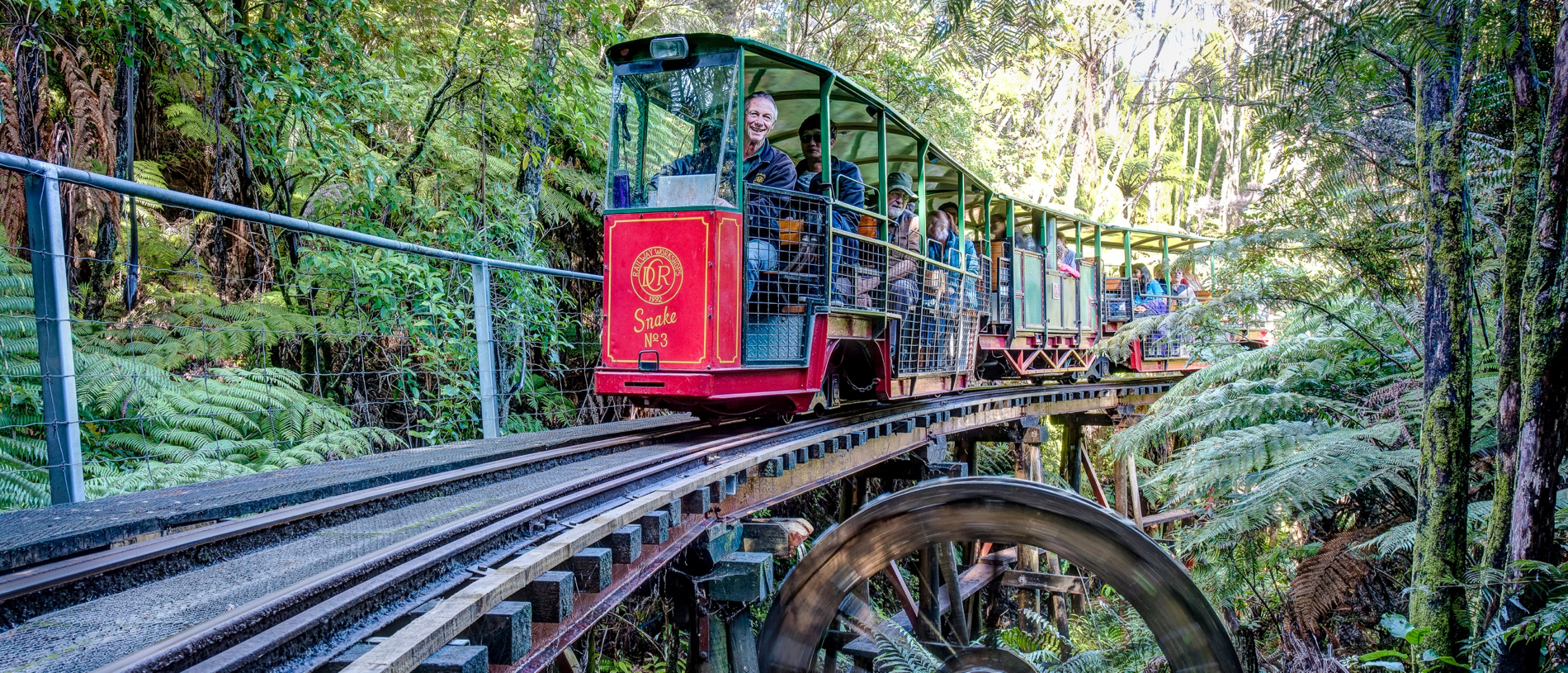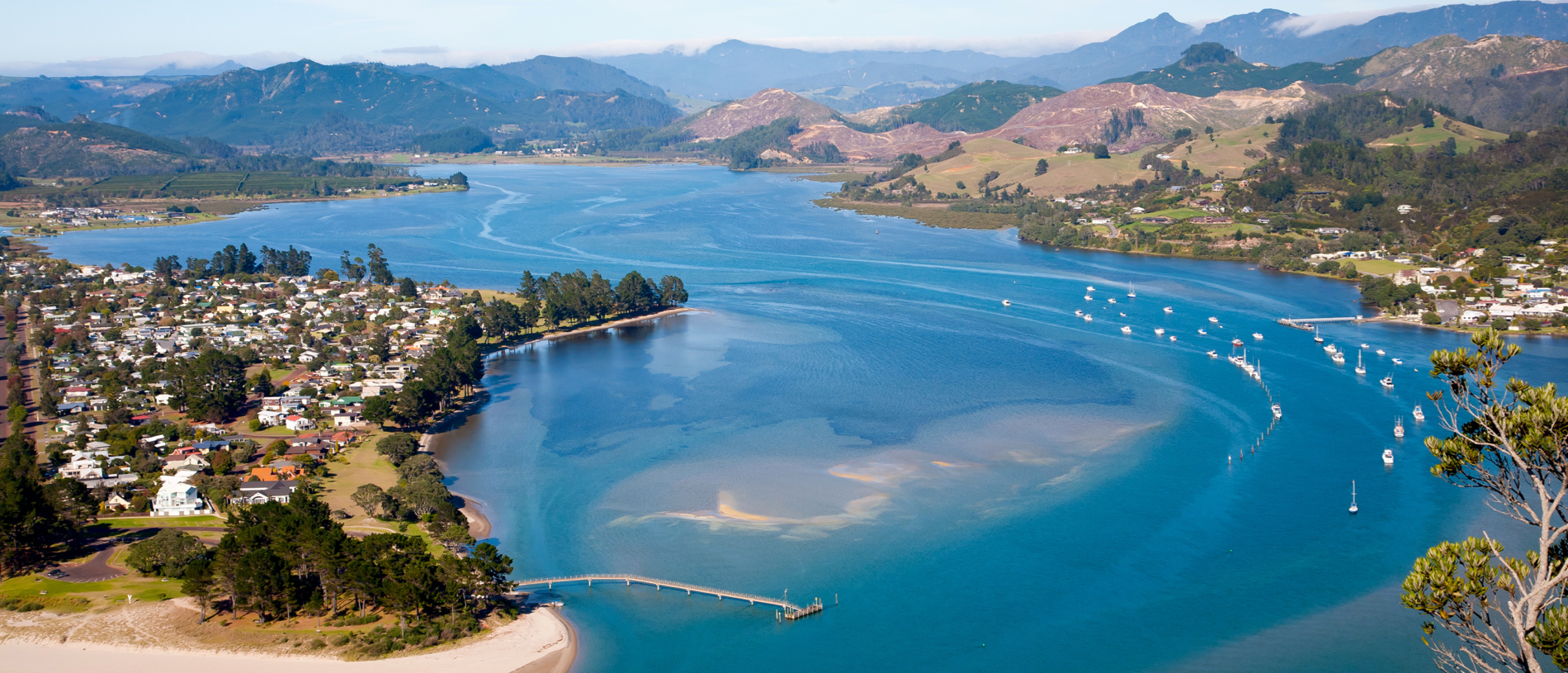
Coromandel Township: hippy haven
Perhaps it’s the stillness of the rainforest, the misty vistas of mountain, headland and sea that called the souls of the commune-founders hither.

If you were to assume that Te Ika a Māui – the Great Fish of Māui – was a species of stingray, with Wellington at its head and Cape Rēinga at its tail, then the 85km protuberance extending north from its ventral districts would be the sting.
That’s the Coromandel Peninsula, or ‘The Coromandel’, as most New Zealanders know it.
The eastern coast of the Coromandel is the site of some of the earliest human encounters with Aotearoa. For Māori, the geography of the peninsula must have been powerfully reminiscent of their Polynesian homelands – white-sand beaches along a habitable fringe backed by a rugged interior, with lagoons abounding in kaimoana.
Then, in August 1867, just days after a goldfield was proclaimed in the vicinity of present-day Thames, more gold was discovered in the Kuranui Stream. Soon the entire peninsula – most notably the region between Thames and Waihī – was honeycombed with mineshafts. To this day, the extraction of gold continues at Waihī.
Since the 1960s, however, The Coromandel has become something of a conservation icon. It is the attractions of the place rather than the potential for extraction that draws visitors.
The Coromandel Peninsula embraces the southernmost extremity of the Hauraki Gulf, a shallow body of water named the Firth of Thames.
The Firth has been branded as ‘the Seabird Coast’, as it also supports vast numbers of shorebirds, most notably the iconic bar-tailed godwit, which masses here in March to make its annual migration to Siberia. Unsurprisingly, birders (or ‘twitchers’, as they’re known) mass here too and their activity is largely centred around the Miranda Shorebird Centre, an excellent interpretive facility where you can join guided bird-watching tours. Miranda is also the site of a natural hot spring, where you can soak away your aches and pains.
Kōpū is the gateway to the Coromandel. But if you turn right here instead of left, you can skirt the Hauraki Plains via Hikutaiā to Paeroa, world famous in New Zealand for L&P (that’s actually where the popular slogan originated) which began life as an ‘aerated water’ named Lemon & Paeroa in 1907.
Getting a selfie with the seven-metre-tall Big Bottle on the outskirts of Paeroa is a Kiwi must-do.
South-east from Paeroa, you enter the Karangahake Gorge, a pretty stretch of road, with several easy walks and light tramps that take in old quartz stamping batteries, tramways, swing bridges and mineshafts. The Karangahake Gorge is also the jewel in the crown of the 147-kilometre cycle trail, the Hauraki Rail Trail. It’s an easy grade, using the terraces and tunnels cut for the railway line that ran from Thames to Hamilton and it has the distinction of passing through the country’s longest cycle trail tunnel (1.1 kilometres).
Other attractions in the Gorge include the Goldfields Heritage Railway, which runs short excursions between Waikino (where there is a café) and Waihī – guaranteed to raise a smile from fans of Thomas the Tank Engine of all ages. And Bullswool Farm offers animal encounters that range from feeding eels and freshwater crayfish to patting alpacas.
It’s a short drive from Waihī via Whiritoa (where there is a decent surf break if sea and sand are in the mood) to Whangamatā, one of the holiday hotspots of the upper North Island.
In many ways, Whangamatā is typical of Coromandel beaches. It comprises dazzling white sand with a tidal estuary at one end and a clutch of little islands just off the other.
For kayakers, a major attraction is Whenuakura, the largest of the four islets off the southern end of the beach, nicknamed ‘Donut Island’ because it has an exquisite, emerald lagoon at its heart that is accessible via an archway opening to the sea. Whenuakura is a wildlife sanctuary and sacred site to the local hapu, Ura-Nga-Wera/Ngāti Pu. If you want to visit, best to do it as part of a guided paddle. Not only will the guides let you know what you can and can’t do, they’ll ensure you get there and back safely. Conditions can change rapidly and, being a kilometre offshore, it’s a very long paddle if the wind springs up. What’s more, because the entrance to the lagoon is via a fifteen-metre high archway that opens to the ocean side of the island, adverse sea conditions can make getting in and out fairly dangerous.
Whangamatā has always been a party town. Several organised events take place here over summer – most notably the annual Whangamatā Beach Hop, which began in 2001 as a classic car, hot-rod and motorcycle meet and has now evolved into a five-day festival of 1950s retro chic and mecca for Elvis impersonators.
The twin settlements of Pāuanui and Tairua lie on opposite sides of the Tairua Harbour. Even amongst the riches of the Coromandel, Pāuanui is blessed with its location – fronted by its glorious beach and looking back to the majestic skyline of the ranges.
Across (or by car, around) the harbour, Tairua, by contrast, is a quaint little place, nestled at the foot of the dramatic Paku – well worth a climb to the trig, especially in the morning, where the views up and down the coast are breathtaking.
The Tairua wharf is one of the best places in the world to sit with a parcel of fish and chips and dangle a line or two in the water as the heat fades from a summer’s evening.
Nearby, Hahei is yet another exquisite beach, and with the matchless Cathedral Cove just around the corner and plenty of equally fascinating limestone landforms en route, it is a sea kayaker’s dream.
Hahei is also one of the twin gateways to a nine km2 marine reserve, where you’ll find the Whanganui-a-Hei snorkel trail – a superb place to learn to snorkel and explore the flora and fauna of The Coromandel’s beautiful reefscapes. There are guided tours available, but if you really don’t want to get wet, tours by glass-bottomed boat depart from both Hahei and Whitianga.
Cook’s Beach is the originally named settlement associated with the place where James Cook anchored to observe the transit of Mercury in 1769. A monument to this event is a short walk from the road at the top of Shakespeare Cliff at the western end of the beach. Cook’s Beach itself is a lovely crescent of white sand which, thanks to the shelter of the headlands enfolding Mercury Bay, is a very safe swimming beach. Safer again is the Purangi estuary at the eastern end.
The principal town on the west coast of the peninsula is Whitianga – short for te Whitianga a Kupe (the crossing place of Kupe). You can reach it from Cook’s Beach either by driving around the harbour – it’s further than you’d think – or by taking a five-minute vehicular ferry ride from Ferry Landing.
The picturesque, tidal Whitianga Harbour is the home port to a fleet of charter vessels that provide fishing, diving and general recreating opportunities of greater Mercury Bay and it’s from here that you can hitch a lift out to the Mercury Islands, lying to the east of the peninsula. Each September, Whitianga hosts the famous Scallop Festival, a celebration not only of that aristocrat of seafood but also of the other kaimoana delights of this special coast.
Kūaotunu is home to a campground in one of the loveliest settings in New Zealand. If you head out to the coast from here, you come to remote and beautiful Ōpito Bay. From Matarangi, State Highway 25 strikes west for Coromandel, but you don’t have to follow.
Even in an area that has more than its fair share of wonderful beaches, the gems that lie along this road less travelled are in a class of their own. They’re there for the taking if you’re prepared to do the mahi and brave some narrow, winding roads, more often than not on gravel.
The broad, horseshoe-shaped Kennedy Bay is a popular swimming beach and like most of the coast is good for surf-casting. Best of all, you’ll find you’ve left most of the crowds behind. Press on, past Waikawau to Port Charles and by the time you’ve reached Stony Bay it will be only you and the determined few, most of whom will be there to do the gorgeous walk over the top of Cape Colville to Fletcher’s Bay. This can be comfortably done in a day – although you’ll need to do it all over again in reverse if you haven’t arranged transport back.
The character of the east coast of the Coromandel is very different to the west.
The coastal strip of flat land is much narrower and the bays, inlets and harbours are tidal. The absence of white sand beaches tends to make the localities along here less popular too, which means they have their own charm. The waters off the coast are spattered with islands that are a popular playground for Auckland boaties and an excellent fishing ground for snapper and blue maomao.
Port Jackson, right out there on the end of the peninsula, feels about as far away from civilisation as it’s possible to get, although you can see the glow of Auckland across the Hauraki Gulf on clear nights.
Visiting Coromandel township is one of those must-dos – even if it is only to sample the green-lipped mussels that are farmed in the shallow harbour. And don’t forget to visit the Driving Creek Railway.
From Coromandel, you drive south along a beautiful strip of road, with pōhutukawa ablaze in summer and the sea glittering to your right. Each of the little localities along the way has their own stories of gold mining boom or bust. Mineshafts pock the cliffs and cuttings – not all of these have been screened off, but that doesn’t mean they are safe to enter. Examine their gloomy portals, but don’t go any further!
The township of Thames is the point at which your circuit of the Coromandel is complete. Thames began life as two smaller townships – Grahamtown and Shortland – which merged to become the largest centre of population in New Zealand during the period 1868 to 1871, with over 100,000 hopeful gold diggers and kauri sawyers calling the place home.
Much of the district’s fascinating and varied history has been preserved in the town’s heritage buildings – notably restored hotels (including New Zealand’s oldest Irish pub, the Brian Boru) – and in the profusion of local museums, of which the Thames Historical Museum and the Thames School of Mines deserve special mention.
Just outside Thames is the Kauaeranga Valley, where you can do the Kauri Trail Walk and get an insight into the glory days of kauri forestry. The Kauaeranga is also the route of one of New Zealand’s best short tramps, the Pinnacles walk, and there is a famed intermediate-grade mountain bike trail, the Hotoritori. Kaueranga is home to Canyonz, which runs some truly hair-raising zipline and abseiling adventures, but the less intrepid might prefer the stroll to Hoffman’s Pool, a popular swimming and picnic spot on the beautiful Kaueranga River.